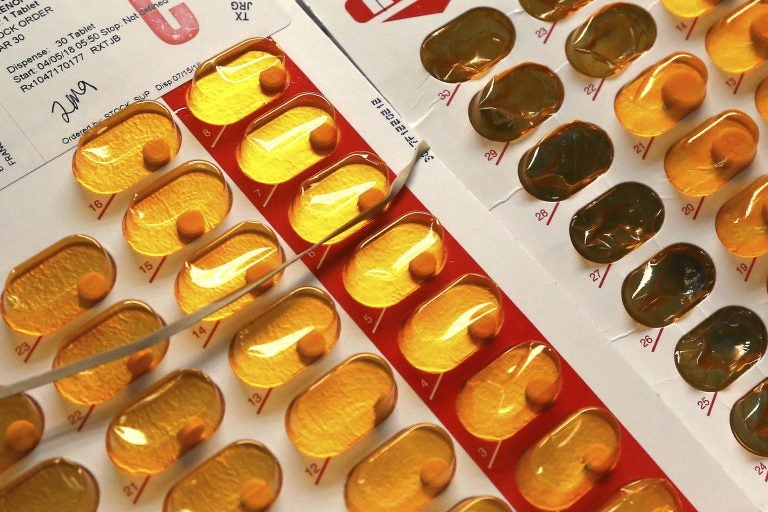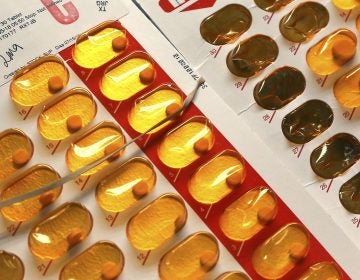Krasner to stop charging for possession of opioid treatment drug popular on the street
Larry Krasner says his office will not prosecute for possession of the controlled substance, an opioid-treatment drug with a thriving black market.

This July 23, 2018 file photo shows packets of buprenorphine, a drug which controls heroin and opioid cravings, in Greenfield, Mass. (Elise Amendola/AP Photo)
For nearly a year, Philadelphia health officials have been pushing one treatment for opioid addiction harder than any other. “Bupe works!” billboards boast across the city and at SEPTA stations.
Buprenorphine, which is often known by its brand name Suboxone, is one of three Food and Drug Administration-approved medications to treat opioid use disorder. But because it’s technically a low-grade opioid, it counts as a controlled substance, and without a prescription, it’s illegal.
Philadelphia District Attorney Larry Krasner announced Tuesday that his office will no longer charge or prosecute people for buprenorphine possession. His will be the second district in the country to do so, after Chittenden County, Vermont (home of Burlington), where authorities say they saw a 50% decrease in overdose deaths after enacting the policy.
Krasner said any pending cases in which the person was charged merely with possession of drugs containing buprenorphine will be reviewed, and the charges dropped. If that was the only charge, the case will be withdrawn. Current penalties for buprenorphine possession depend on an individual’s prior record, but the maximum penalty for a first offense is one year of incarceration and/or a $5,000 fine; for a second or subsequent offense, the maximum penalty is three years’ incarceration and/or a $25,000 fine.
When used as prescribed, buprenorphine is taken as a pill or dissolving film. It mitigates the symptoms of withdrawal and reduces cravings. It can produce euphoric effects like any opioid, but to a lesser degree than a drug like heroin or fentanyl. It is unlikely anyone would overdose on it, in part because it is often combined with naloxone, to create a ceiling effect.
Those qualities make buprenorphine popular among many people in active addiction, too. It’s often taken as a bridge between highs, so people don’t have to undergo the unpleasant and painful symptoms of withdrawal while working or between opportunities to use. Because of that, it has high resale value on the street.
“They’re using it because they are going through withdrawal and they don’t have the ability to get heroin or fentanyl and it makes it livable for a day,” Krasner said. “I don’t want people to use fentanyl — I don’t want them to use heroin. But if it means that it’s going to stop them from robbing a corner store to get money to go get heroin, then in that way, it also reduces harm.”
The number of people on Medicaid receiving buprenorphine treatment in Philadelphia expanded dramatically from 881 people in 2015 to more than 5,000 in 2018. Still, health officials, harm-reduction advocates and addiction specialists have found themselves facing an uphill battle promoting the drug, in part because it’s long been viewed by those in the recovery community as a “crutch.” Since they are technically opioids, many view being on buprenorphine or methadone as simply replacing one drug with another. As of March 2019, the city reports it had about 12,000 slots for medication-assisted treatment; a quarter were open and available.
Yet its reputation in the recovery world isn’t the only hurdle to opening people’s minds to buprenorphine. Krasner acknowledged that it was time to stop sending mixed messages by both promoting and criminalizing the drug.
“I think it’s very strange when you’re dealing with a massive epidemic of fatal overdoses to be priggish about whether people have a prescription for something that is treatment for opioids,” he said.
Krasner conceded there aren’t many cases where someone is charged for possessing buprenorphine illegally — maybe a couple hundred a year in Philadelphia, he estimated. (For reference, in 2019 there were 12,844 total drug charges in Philadelphia.) But Krasner said that exercising his prosecutorial discretion in this way was indicative of a broader public health approach to criminal justice that this administration and other progressive district attorneys are taking.
“We are choosing not to use all the power we have, when using all the power we have makes things worse,” he said, in what was an apparent jab at a common refrain among law-and-order prosecutors.
Taking the opposite approach toward people struggling with addiction, U.S. Attorney William McSwain, with whom Krasner has sparred in the past, has vowed to consider “all available enforcement tools at our disposal” to crack down on the proposed supervised injection site that the nonprofit Safehouse plans to open as soon as it has legal authority.
WHYY is your source for fact-based, in-depth journalism and information. As a nonprofit organization, we rely on financial support from readers like you. Please give today.





